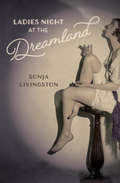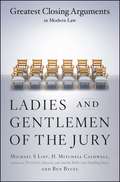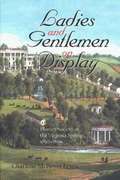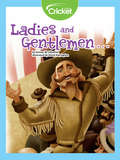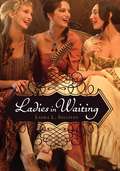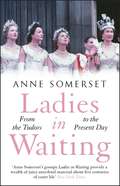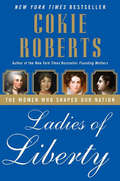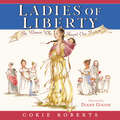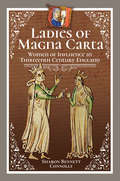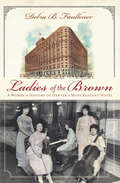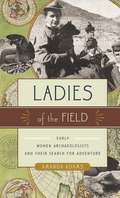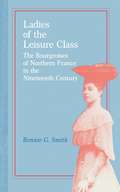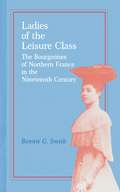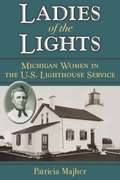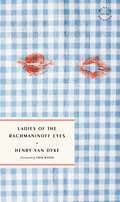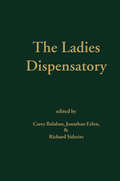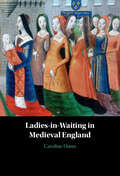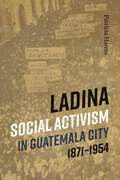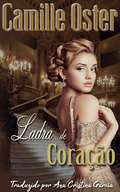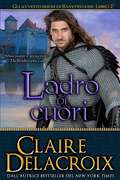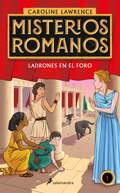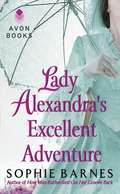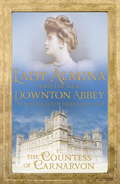- Table View
- List View
Ladies Night at the Dreamland (Crux: The Georgia Series in Literary Nonfiction)
by Sonja LivingstonTales of female daredevils, warriors, killers, and victims: &“Radiant essays inspired by &‘slivers and bits&’ of real women's lives…Wise, fresh, captivating.&”—Kirkus Reviews (starred review) At the Dreamland, women and girls flicker from the shadows to take their proper place in the spotlight. In this lyrical collection, Sonja Livingston weaves together strands of research and imagination to conjure figures from history, literature, legend, and personal memory. The result is a series of essays that highlight lives as varied, troubled, and spirited as America itself. Livingston breathes life into subjects who led extraordinary lives—as rule-breakers, victims, or those whose differences made them cultural curiosities—bringing together those who slipped through the world largely unseen with those whose images were fleeting or faulty so that they, too, remained relatively obscure. Included are Alice Mitchell, a Memphis society girl who murdered her female lover in 1892; Maria Spelterini, who crossed Niagara Falls on a tightrope in 1876; May Fielding, a &“white slave girl&” buried in a Victorian cemetery; Valaida Snow, a Harlem Renaissance trumpeter; a child exhibited as Darwin&’s Missing Link; the sculptors&’ model Audrey Munson; a Crow warrior; victims of a 1970s serial killer; the Fox Sisters; and many more.
Ladies and Gentlemen of the Jury: Greatest Closing Arguments in Modern Law
by Michael S. LiefUntil now, only the twelve jurors who sat in judgment were able to appreciate these virtuoso performances, where weeks of testimony were boiled down and presented with flair, wit, and high drama. For five years the authors researched every archive from those of the L.A. Times to the dusty stacks of the National Archives in Washington, D.C., and readers can now lose themselves in the summations of America's finest litigators. Clarence Darrow saves Leopold and Loeb from the gallows in the Roaring Twenties. Gerry Spence takes on the nuclear power industry for the death of Karen Silkwood in a modern-day David and Goliath struggle. Vincent Bugliosi squares off against the madness of Charles Manson and his murderous "family" in the aftermath of their bloody spree. Clara Foltz, the first woman to practice law in California, argues passionately to an all-male jury, defending her place in the courtroom. Bobby DeLaughter brings the killer of civil-rights leader Medgar Evers to justice after thirty years and two mistrials. Aubrey Daniel brings Lt. William Calley, Jr., to justice for the My Lai massacre. William Kunstler challenges the establishment after the '68 Chicago riots in his defense of yippie leaders known as the Chicago Seven. Each closing argument is put into context by the authors, who provide historical background, a brief biography of each attorney, and commentary, pointing out the trial tactics used to great effect by the lawyers, all in language that is jargon-free for the benefit of the lay reader.
Ladies and Gentlemen on Display
by Charlene M. LewisEach summer between 1790 and 1860, hundreds and eventually thousands of southern men and women left the diseases and boredom of their plantation homes and journeyed to the healthful and entertaining Virginia Springs. While some came in search of a cure, most traveled over the mountains to enjoy the fashionable society and participate in an array of social activities. At the springs, visitors, as well as their slaves, interacted with one another and engaged in behavior quite different from the picture presented by most historians. In the leisurely and pleasure-filled environment of the springs, plantation society's hierarchies became at once more relaxed and more contested; its rituals and rules sometimes changed and reformed; and its gender divisions often softened and blurred.In Ladies and Gentlemen on Display, Charlene Boyer Lewis argues that the Virginia Springs provided a theater of sorts, where contests for power between men and women, fashionables and evangelicals, blacks and whites, old and young, and even northerners and southerners played out--away from the traditional roles of the plantation. In their pursuit of health and pleasure, white southerners created a truly regional community at the springs. At this edge of the South, elite southern society shaped itself, defining what it meant to be a "Southerner" and redefining social roles and relations.
Ladies and Gentlemen...
by Jeremy M. JohnstonLearn about Buffalo Bill Cody's life and how his traveling Wild West show introduced a generation of people to the American West.
Ladies in Waiting
by Laura L. SullivanEliza dreams of being a playwright for the king's theater, where she will be admired for her witty turns of phrase rather than her father's wealth. Beth is beautiful as the day but poor as a church mouse, so she must marry well, despite her love for her childhood sweetheart. Zabby comes to England to further her scientific studies--and ends up saving the life of King Charles II. Soon her friendship with him becomes a dangerous, impossible obsession. Though she knows she should stay away from the young, handsome king, Charles has a new bride, Queen Catherine, and a queen needs ladies in waiting. And so Zabby, Beth, and Eliza, three Elizabeths from very different walks of life, find themselves at the center of the most scandal-filled court that England has ever seen.
Ladies in Waiting: a history of court life from the Tudors to the present day
by Anne Somerset'Provides a wealth of juicy anecdotal material about five centuries of court life' New York Times'Naughty Knickers version of our island story' Daily Mail---------------------------------------------Ladies in Waiting chronicles the lives of famous and infamous ladies who served royalty, casting a fresh, intimate angle on four hundred years of monarchy. For centuries, the most beautiful, able and aristocratic women in England competed for positions at court. Some who came to serve were remarkable for their learning and exemplary virtue, but others were notable for promiscuity and lack of scruple, drawn to court by a lust for money and power. Several ladies-in-waiting became royal mistresses, showing few qualms about betraying the queen consorts they ostensibly served. If bedding the King was not an option open to all, many ladies came to court in hope of finding husbands, only to succumb to constant assaults on their virtue or to find themselves denied permission by their sovereign to marry. Drawing on an enormous variety of sources, Anne Somerset provides an illuminating guide to the character, profligate or pious, of each court. Contained within the stories of the individual women is a consistently entertaining commentary on the manners, morals and shifting mentality of the royal, the rich, and the prominent throughout the centuries, resulting in social history at its most enjoyable and vibrant.
Ladies in Waiting: a history of court life from the Tudors to the present day
by Anne Somerset'Provides a wealth of juicy anecdotal material about five centuries of court life'New York Times'Naughty Knickers version of our island story' Daily Mail---------------------------------------------Ladies in Waiting chronicles the lives of famous and infamous ladies who served royalty, casting a fresh, intimate angle on four hundred years of monarchy. For centuries, the most beautiful, able and aristocratic women in England competed for positions at court. Some who came to serve were remarkable for their learning and exemplary virtue, but others were notable for promiscuity and lack of scruple, drawn to court by a lust for money and power. Several ladies-in-waiting became royal mistresses, showing few qualms about betraying the queen consorts they ostensibly served. If bedding the King was not an option open to all, many ladies came to court in hope of finding husbands, only to succumb to constant assaults on their virtue or to find themselves denied permission by their sovereign to marry. Drawing on an enormous variety of sources, Anne Somerset provides an illuminating guide to the character, profligate or pious, of each court. Contained within the stories of the individual women is a consistently entertaining commentary on the manners, morals and shifting mentality of the royal, the rich, and the prominent throughout the centuries, resulting in social history at its most enjoyable and vibrant.
Ladies of Liberty: The Women Who Shaped Our Nation
by Cokie RobertsIn Founding Mothers, Cokie Roberts paid homage to the heroic women whose patriotism and sacrifice helped create a new nation. Now the number one New York Times bestselling author and renowned political commentator-praised in USA Today as a "custodian of time-honored values"-continues the story of early America's influential women with Ladies of Liberty. In her "delightfully intimate and confiding" style (Publishers Weekly), Roberts presents a colorful blend of biographical portraits and behind-the-scenes vignettes chronicling women's public roles and private responsibilities. Recounted with the insight and humor of an expert storyteller and drawing on personal correspondence, private journals, and other primary sources-many of them previously unpublished-Roberts brings to life the extraordinary accomplishments of women who laid the groundwork for a better society. Almost every quotation here is written by a woman, to a woman, or about a woman. From first ladies to freethinkers, educators to explorers, this exceptional group includes Abigail Adams, Margaret Bayard Smith, Martha Jefferson, Dolley Madison, Elizabeth Monroe, Louisa Catherine Adams, Eliza Hamilton, Theodosia Burr, Rebecca Gratz, Louisa Livingston, Rosalie Calvert, Sacajawea, and others. In a much-needed addition to the shelves of Founding Father literature, Roberts sheds new light on the generation of heroines, reformers, and visionaries who helped shape our nation, giving these ladies of liberty the recognition they so greatly deserve.
Ladies of Liberty: The Women Who Shaped Our Nation
by Cokie Roberts“This collection succeeds in emphasizing that many unsung women left their mark well before the suffrage movement.” —Publishers WeeklyFans of #1 New York Times bestselling author Cokie Roberts, who was also a celebrated journalist for ABC and NPR, will love this stunning nonfiction picture book, as will parents and educators looking for a more in-depth book beyond the Rosie Revere and Rad Women series.Highlighting the female explorers, educators, writers, and political and social activists that shaped our nation’s early history, this is the stunning follow-up to the acclaimed children’s book Founding Mothers.Beautifully illustrated by Caldecott Honor–winning artist Diane Goode, Ladies of Liberty pays homage to a diverse selection of ten remarkable women who have shaped the United States, covering the period 1776 to 1824.Drawing on personal correspondence and private journals, Cokie Roberts brings to life the extraordinary accomplishments of these women who created the framework for our current society, a generation of reformers and visionaries. Roberts features a cast of courageous heroines that includes African American poet Lucy Terry Prince, Native American explorer Sacagawea, first lady Louisa Catherine Adams, Judith Sargent Murray, Isabella Graham, Martha Jefferson Randolph, Elizabeth Bayley Seton, Louise D’Avezac Livingston, Rebecca Gratz, and Elizabeth Kortright Monroe.This compelling book offers a rich timeline, biographies, and an author note, bringing these dynamic ladies to life.
Ladies of Magna Carta: Women of Influence in Thirteenth Century England
by Sharon Bennett ConnollyAn innovative take on Magna Carta history that examines the impact and influence of women. 39. No man shall be taken, imprisoned, outlawed, banished or in any way destroyed, nor will we proceed against or prosecute him, except by the lawful judgment of his peers or by the law of the land. This clause in Magna Carta was in response to the appalling imprisonment and starvation of Matilda de Braose, the wife of one of King John&’s barons. Matilda was not the only woman who influenced, or was influenced by, the 1215 Charter of Liberties, now known as Magna Carta. Women from many of the great families of England were affected by the far-reaching legacy of Magna Carta, from their experiences in the civil war and as hostages, to calling on its use to protect their property and rights as widows. Ladies of Magna Carta looks into the relationships—through marriage and blood—of the various noble families and how they were affected by the Barons&’ Wars, Magna Carta, and its aftermath—the bonds that were formed and those that were broken. Including the royal families of England and Scotland, the Marshals, the Warennes, the Braoses, and more, Ladies of Magna Carta focuses on the roles played by the women of the great families whose influences and experiences have reached far beyond the thirteenth century.
Ladies of the Brown: A Women's History of Denver's Most Elegant Hotel (Landmarks)
by Debra B. Faulkner&“Amusing and little-known anecdotes&” about the hotel&’s female guests including Hillary Rodham Clinton, Zsa Zsa Gabor, Joan Baez, Helen Keller, and others (The Denver Post). Since the day it opened in 1892, Denver&’s Brown Palace Hotel has been the Mile High City&’s foremost destination for high-powered business travelers, celebrities, royalty and politicians. In Ladies of the Brown, hotel historian and archivist Debra B. Faulkner introduces readers to some of the hotel&’s most fascinating and famous female visitors, residents and employees. From Denver&’s &“Unsinkable&” Molly Brown and Romania&’s Queen Marie to Zsa Zsa Gabor, Mamie Eisenhower and many, many more, these intriguing characters play leading roles in true tales of romance, scandal, humor and heartbreak. This collection of stories is integral to the history of the Brown Palace and Denver, offering a glimpse into the lives of generations of women from all walks of life. &“Crafted by Brown Palace historian and archivist Debra Faulkner, this well written, well-researched and thoroughly entertaining book presents amazing stories one can hardly believe are true.&” —Colorado Country Life, &“The Year&’s Best Books&” &“What fun we had learning about this amazing assortment of characters, all real, and this building so well-appointed and enduring.&” —Mountain States Collector
Ladies of the Field: Early Women Archaeologists and Their Search for Adventure
by Amanda AdamsThe first women archaeologists were Victorian era adventurers who felt most at home when farthest from it. Canvas tents were their domains, hot Middle Eastern deserts their gardens of inquiry and labor. <P><P>Thanks to them, prevailing ideas about feminine nature - soft, nurturing, submissive - were upended. Ladies of the Field tells the story of seven remarkable women, each a pioneering archaeologist, each headstrong, smart, and courageous, who burst into what was then a very young science. Amanda Adams takes us with them as they hack away at underbrush under a blazing sun, battle swarms of biting bugs, travel on camelback for weeks on end, and feel the excitement of unearthing history at an archaeological site. Adams also reveals the dreams of these extraordinary women, their love of the field, their passion for holding the past in their hands, their fascination with human origins, and their utter disregard for convention.
Ladies of the Leisure Class: The Bourgeoises of Northern France in the 19th Century
by Bonnie G. SmithIn a social and cultural study of nineteenth-century bourgeois women in northern France, Bonnie Smith shows how the advent of industrialization removed women from the productive activity of the middle class and confined them to a largely reproductive experience. Out of this, she suggests, they created their own world, centered on domesticity, family, and religion. To understand these women, the author argues, it is necessary to examine their world on its own terms as a coherent whole. Professor Smith draws on demographic, psychoanalytic, anthropological, linguistic, as well as historical insights and uses a variety of evidence that includes personal interviews, photographs, letters, genealogical records, and traditional archival sources. Part One outlines the transition from mercantile to industrial manufacturing that terminated the relationship between home and business and that separated the sexes according to their respective functions. Part Two concentrates on the lives of the women following their acceptance of an exclusively reproductive function and shows how the interdependence and fusion of household chores, religious values, and social conscience fostered a unified cultural system. Part Three, then, explores the propagation of this domesticity by the convent, as the primary educational system, and by the sentimental novel, as the vehicle most suited for an ideological expression of domestic life.
Ladies of the Leisure Class: The Bourgeoises of Northern France in the 19th Century
by Bonnie G. SmithIn a social and cultural study of nineteenth-century bourgeois women in northern France, Bonnie Smith shows how the advent of industrialization removed women from the productive activity of the middle class and confined them to a largely reproductive experience. Out of this, she suggests, they created their own world, centered on domesticity, family, and religion. To understand these women, the author argues, it is necessary to examine their world on its own terms as a coherent whole.Professor Smith draws on demographic, psychoanalytic, anthropological, linguistic, as well as historical insights and uses a variety of evidence that includes personal interviews, photographs, letters, genealogical records, and traditional archival sources. Part One outlines the transition from mercantile to industrial manufacturing that terminated the relationship between home and business and that separated the sexes according to their respective functions. Part Two concentrates on the lives of the women following their acceptance of an exclusively reproductive function and shows how the interdependence and fusion of household chores, religious values, and social conscience fostered a unified cultural system. Part Three, then, explores the propagation of this domesticity by the convent, as the primary educational system, and by the sentimental novel, as the vehicle most suited for an ideological expression of domestic life.
Ladies of the Lights: Michigan Women in the U.S. Lighthouse Service
by Patricia Majher"A great read about some great ladies, Pat Majher'sLadies of the Lightspays long overdue homage to an overlooked part of Great Lakes maritime history in which a select group of stalwart women beat the odds to succeed in a field historically reserved for men. " ---Terry Pepper, Executive Director of Great Lakes Lighthouse Keeper's Association Michigan once led the country in the number of lighthouses, and they're still a central part of the mystique and colorful countryside of the state. What even the region's lighthouse enthusiasts might not know is the rich history of female lighthouse keepers in the area. Fifty women served the sailing communities on Lakes Huron, Michigan, and Superior, as well as on the Detroit River, for more than 100 years. From Catherine Shook, who raised eight children while maintaining the Pointe Aux Barques light at the entrance to Saginaw Bay; to Eliza Truckey, who assumed responsibility for the lighthouse in Marquette while her husband fought for four years in the Civil War; to Elizabeth Whitney, whose combined service on Beaver Island and in Harbor Springs totaled forty-one years---the stories of Michigan's "ladies of the light" are inspiring. This is no technical tome documenting the minutiae of Michigan's lighthouse specifications. Rather, it's a detailed, human portrait of the women who kept those lighthouses running, defying the gender expectations of their time. Patricia Majher is Editor ofMichigan Historymagazine, published by the Historical Society of Michigan. Prior, she was Assistant Director of the Michigan Women's Historical Center and Hall of Fame in Lansing, Michigan. In addition, she has been writing both advertising and editorial copy for almost thirty years and has been a frequent contributor to Michigan newspapers and magazines.
Ladies of the Rachmaninoff Eyes
by Henry Van DykeA lost midcentury classic—the farcical misadventures of a queer Black teen sharing a house with two adoptive mothers, a lascivious cook, and a reticent ghost.In a small Michigan town, in the late 1950s, the widow Etta Klein—wealthy and Jewish—has for more than thirty years relied for aid, comfort, and companionship on her Black housekeeper Harriet Gibbs. Between &“Aunt Harry&” and Etta, a relationship has developed that is closer than a friendship, yet not quite a marriage. They are inseparable, at once absurdly unequal and defined by a comic codependence. Forever mourning the early death of her favorite son, Sargent, Etta has all but adopted Aunt Harry&’s nephew, the precocious, gay seventeen-year-old Oliver, who has been raised by both women. Oliver is facing down his departure to college—and fending off the advances of Etta&’s cook, Nella Mae—when the household is disrupted by the arrival of a self-proclaimed &“warlock,&” one Maurice LeFleur, who has convinced Etta and Harry that he might be able to contact Sargent in the afterlife . . . Ladies of the Rachmaninoff Eyes was the debut of the extraordinary Henry Van Dyke, whose witty and outrageous novels look back to the sparkling, elaborate comedies of Ronald Firbank and forward to postmodern burlesques like Fran Ross&’s Oreo. There is nothing else quite like them in American fiction.
Ladies of the Ticker: Women and Wall Street from the Gilded Age to the Great Depression
by George RobbLong overlooked in histories of finance, women played an essential role in areas such as banking and the stock market during the late nineteenth and early twentieth centuries. Yet their presence sparked ongoing controversy. Hetty Green's golden touch brought her millions, but she outraged critics with her rejection of domesticity. Progressives like Victoria Woodhull, meanwhile, saw financial acumen as more important for women than the vote. George Robb's pioneering study sheds a light on the financial methods, accomplishments, and careers of three generations of women. Plumbing sources from stock brokers' ledgers to media coverage, Robb reveals the many ways women invested their capital while exploring their differing sources of information, approaches to finance, interactions with markets, and levels of expertise. He also rediscovers the forgotten women bankers, brokers, and speculators who blazed new trails--and sparked public outcries over women's unsuitability for the predatory rough-and-tumble of market capitalism. Entertaining and vivid with details, Ladies of the Ticker sheds light on the trailblazers who transformed Wall Street into a place for women's work.
Ladies' Dispensatory
by Carey Balaban Jonathan Erlen Richard SederitsLeonard Sowerby's self-healing manual for women, The Ladies' Dispensatory, emerged in England in 1652 amidst an abundance of medical self-help books for the lay citizen. Written for both the common patient and the amateur health provider, these manuals of home remedies provided their readers with a variety of potential solutions to common ailments or disease. Sowerby's Dispensatory was written primarily for curing women's health problems, and in that regard, focuses heavily on gynecologic problems (the Dispensatory includes numerous preparations for inducing abortion), breast complaints, personal hygiene and cosmetic applications.Balaban, Erlen and Siderits have resurrected Sowerby's original manuscript and have provided both historical and medical explanation of its uses and usefulness. From a common garlic remedy to 'fortify the brain' to 'a hog's heel, burned to powder' for easing colic, The Ladies' Dispensatory is a delightfully unique look at health and hygiene in the seventeenth century. Also inlcludes nine maps.
Ladies-in-Waiting in Medieval England
by Caroline DunnLadies-in-Waiting in Medieval England examines female attendants who served queens and aristocratic women during the late medieval period. Using a unique set of primary source based statistics, Caroline Dunn reveals that the lady-in-waiting was far more than a pretty girl sewing in the queen's chamber while seeking to catch the eye of an eligible bachelor. Ladies-in-waiting witnessed major historical events of the era and were sophisticated players who earned significant rewards. They had both family and personal interests to advance – through employment they linked kin and court, and through marriage they built bridges between families. Whether royal or aristocratic, ladies-in-waiting worked within gendered spaces, building female-dominated social networks, while also operating within a masculine milieu that offered courtiers of both sexes access to power. Working from a range of sources wider than the subjective anecdote, Dunn presents the first scholarly treatment of medieval English ladies-in-waiting.
Ladina Social Activism in Guatemala City, 1871-1954
by Patricia HarmsIn this groundbreaking new study on ladinas in Guatemala City, Patricia Harms contests the virtual erasure of women from the country&’s national memory and its historical consciousness. Harms focuses on Spanish-speaking women during the &“revolutionary decade&” and the &“liberalism&” periods, revealing a complex, significant, and palpable feminist movement that emerged in Guatemala during the 1870s and remained until 1954. During this era ladina social activists not only struggled to imagine a place for themselves within the political and social constructs of modern Guatemala, but they also wrestled with ways in which to critique and identify Guatemala&’s gendered structures within the context of repressive dictatorial political regimes and entrenched patriarchy. Harms&’s study of these women and their struggles fills a sizeable gap in the growing body of literature on women&’s suffrage, social movements, and political culture in modern Latin America. It is a valuable addition to students and scholars studying the rich history of the region.
Ladra de Coração
by Camille OsterRowan Cox, antigo investigador da Bow Street, não investiga casos comuns como arrombamentos, mas o Comissário da recém estabelecida Polícia Metropolitana quer que ele capture o ladrão aterrorizando as famílias mais elegantes de Londres. A ladra é habilidosa e astuta, totalmente diferente do que Rowan esperava quando o obrigaram a pegar o caso. Além, de desafiá-lo em cada ação. Apenas um ganharia este jogo de apostas alta, e Rowan estava certo que seria ele. Em hipótese alguma, Serephina Woodford poderia permitir que Rowan Cox se aproximasse dela, tendo sido avisada sobre seus métodos rudes. Ela está bem perto de atingir seu objetivo, e precisava persistir por mais alguns meses e prover um futuro decente para sua irmã. Só precisava ser mais esperta do que o homem que a investigava.
Ladro di cuori (Gli avventurieri di Ravensmuir #2)
by Claire DelacroixCaro lettore, sono consapevole di aver agito in modo sfrontato, sfacciato e imperdonabile...e ammetto di non poter incolpare altri che me stessa. Sapevo con che tipo d'uomo avevo a che fare, sapevo che Gawain Lemmergeier era una canaglia e un malfattore. Eppure, quando ho tramato per sedurlo e reclamare ciò che era mio di diritto, non avrei mai immaginato che avrei ceduto al fascino di questo spericolato mascalzone dai capelli dorati. Sia chiaro, ho recuperato ciò per cui sono venuta, ovvero la sacra reliquia rubata a mio padre in grado di ristabilire le sorti del mio maniero, e mi sarei anche accontentata di tornare a casa con la mia ricompensa. Ma, ahimè, ho lasciato che il desiderio prendesse il controllo delle mie azioni. Perchè sì...mentre cercavo il mio tesoro, ho osato indurre in tentazione Gawain, gli ho permesso di battermi, di stregarmi e persino di portarmi a letto. Lady Evangeline di Inverfyre "Affascinante e avvincente!" TheBestReviews.com
Ladrones en el foro (Misterios romanos #Volumen 1)
by Caroline LawrenceCon este primer volumen comienza la serie «Misterios romanos», protagonizada por Flavia Gémina y su pandilla, que además de ofrecer a los niños entretenidas historias de detectives les contarán cómo era la vida en la antigua Roma. Año 79 d.C. Flavia Gémina, hija de un marino romano, está a punto de vivir una emocionante aventura. Al investigar el paradero de un anillo que lleva el sello de su padre, Flavia conoce a Jonatán, un niño judío, a Nubia, una niña esclava africana, y a Lupo, el pequeño mendigo mudo. A partir de entonces, los cuatro nuevos amigos comenzarán las pesquisas para resolver la misteriosa muerte de unos perros, recorriendo juntos el foro, la necrópolis romana y el puerto de Ostia, y lo que es mejor, se convertirán en muy buenos amigos.
Lady Alexandra's Excellent Adventure
by Sophie BarnesIt's going to be a wild ride . . . Lady Alexandra Summersby is not your average society miss. Not only is she more likely to climb a tree than she is to wear a dress, but she has also sworn off marriage. Alex loves taking chances, which is how she finds herself embroiled in a secret mission as she races across the country with the Earl of Trenton. But Alexandra is about to discover that the real danger lies not in duels, but in her completely unexpected reaction to Lord Trenton's company. Michael Ashford, Earl of Trenton, is a man of duty. Honorable, charming, and a hit with the ladies, he's never had trouble staying focused-until now. Lady Alexandra is like no other woman he's ever met, and suddenly the prospect of marriage seems far more appealing. Now, to convince Alexandra that a life together could be an adventure like no other . . .
Lady Almina and the Real Downton Abbey: The Lost Legacy of Highclere Castle
by Countess Of Carnarvon'Bright, breezy and unpretentious' Guardian'A loving and faithful portrait of Almina and her world' Countryfile magazine* * * * * *The story of the real Downton Abbey, told by Lady Fiona Carnarvon, chatelaine of Highclere Castle where the phenomentally successful TV series was filmed.Lady Fiona Carnarvon became the chatelaine of Highclere Castle - the setting of the hit series Downton Abbey - eight years ago. In that time she's become fascinated by the rich history of Highclere, and by the extraordinary people who lived there over the centuries. One person particularly captured Fiona's imagination - Lady Almina, the 5th Countess of Carnarvon. Almina was the illegitimate daughter of banking tycoon Alfred de Rothschild. She was his only daughter and he doted on her. She married the 5th Earl of Carnarvon, at 19, with an enormous dowry. At first, life at Highclere was a dizzying mix of sumptuous banquets for 500 and even the occasional royal visitor. Almina oversaw 80 members of staff - many of whom came from families who had worked at Highclere for generations. But when the First World War broke out, life at Highclere changed forever. History intervened and Almina and the staff of Highclere were thrown into one of the most turbulent times of the last century. Almina was forced to draw on her deepest reserves of courage in order to ensure her family, the staff and the castle survived. This is the remarkable story of a lost time. But Highclere remains and in this book, Fiona weaves Almina's journey and those of her family into the heritage and history of one of England's most exquisite Victorian castles.
